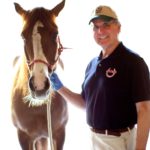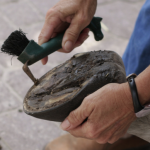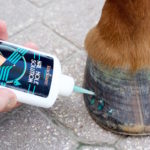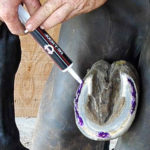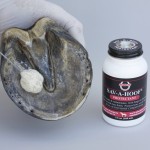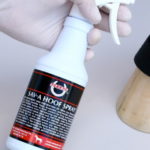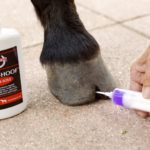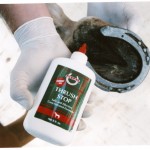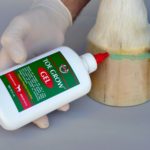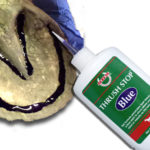Beware of the Quick-Fit
After 35 years in the hoof care business, I have learned that the first line of defense against hoof disease should be your farrier. However, most horse owners I know want an inexpensive treatment for fighting hoof disease, and they want it fixed immediately! The most common hoof diseases include thrush, white line disease, seedy toe, candida yeast, fungus, mold, aerobic and anaerobic bacteria.
Once identified, horse owners expect their farrier to do a quick-fix on a suspected hoof infection as a part of their routine trimming and shoeing. The reality is that deeply rooted infections such as white line disease and chronic thrush are nearly impossible to eradicate with one application of any topical agent.
Bacteria and fungi are very adept at hiding among healthy hoof tissue through millions of years of evolution. One application of a robust chemical agent usually will not stop an infection early enough. Repeated use of these chemical agents can be counterproductive. Caustic chemicals may be temporally effective against bacteria and fungi, but their continued use can be harmful to surrounding healthy hoof tissue and slow the healing process.
An Action-Plan That Works
When a hoof disease is identified, the horse owner or handler should share the responsibility for the follow-up treatment in between farrier appointments. Your farrier or vet’s recommendations on what topical agents to use and how frequently they should be applied are essential to a successful Action-Plan.
Removing diseased tissue and trimming the flaps of the frog are critical first steps to be done by the farrier. Trimming opens up the hooves to oxygen which gives a head start to the healing process. Improperly trimmed feet prevent oxygen or topical ingredients from entering the crevices where the disease usually progresses.
The One Home Remedy That Always Works
There are inexpensive treatments for fighting hoof diseases that we know work well. The horse owner should ensure that the feet are cleaned regularly by washing and picking & brushing with a good hoof pick. In addition, many professional farriers recommend well-established commercial preparations for treatments that are known to be safe and effective against hoof disease. They know that home remedy recommendations, no matter how well-intended, can be dangerous and lead to permanent damage to the hoof structure, and lead to possible litigation if the home remedies prove damaging.
Hoof researchers have discovered that there are many economical hoof treatments that can stop bacteria and fungi without harming sensitive hoof tissue. There are a few non-prescription pharmaceutical strength formulas that are sold over the counter that are not harsh or harmful to hoof tissue when used as directed. They are much safer to use than caustic home remedies.
This keeps the infections under control and gives the healthy hoof tissue a chance to grow-out and prosper as nature intended. Do not expect to kill all of the dangerous organisms initially. Consistent use of an eco-friendly commercial product can slow the advancement of disease to the point where it may grow out with successive trimmings by the farrier.
The Most Common Hoof Problems & Brands Most Recognized by Farriers
HOOF WALL – Hoof researchers have introduced safe and effective topical spray treatments for the hoof wall, sole, and frog. They are used for prevention and early intervention—ingredients bond to hoof protein and form an antiseptic barrier against infection for long-lasting protection. The hoof’s diseases include white line disease, seedy toe, thrush, stubborn candida yeast, fungus, mold, anaerobic and aerobic bacteria. TOE & HEELS – Infections in toes and heels can be severe and progress rapidly if not treated quickly. These areas can be treated easily by handlers with either medical gels or liquid formulas using syringes, sprayers, daubers, brushes, squeeze bottles, or soaking boots. Treat after daily grooming or as directed by the farrier. FROG CLEFTS – After routine trimming by the farrier, frequent picking and brushing by the horse owner are critical steps for preventing or treating thrush in the clefts of the frog. Avoid using household caustic chemicals, which can delay the healing process. Use proven gel or liquid commercial preparations with a successful track record at defeating thrush without harming healthy hoof tissue. CORONET BAND – The Coronary band is the soft skin that the horse’s hoof grows from… just like the cuticles on our fingers. There are copper-peptide remedies available that improve hoof growth and repair cell damage by stimulating blood flow and collagen production. There are specific commercial topical products that are effective for white line disease and abscess exits. Some of these products travel down the horn tubules, which are open at the hairline. Summary – The Future of Hoof Care is Here
When a hoof problem has been observed, the farrier and horse owner should establish a Game Plan for early intervention. The Game Plan should include a weekly maintenance schedule and product recommendations for early treatment.
Stain-marking gel products are gaining in popularity. They turn diseased hoof tissue a dark blue color. The stain shows where to add more gel as the color fades. Gel products are used frequently along the horn rim, in voids, nail holes, under shoes, and pads.
These time-release gel formulas are longer lasting than liquids and improve the critical contact time that is needed to affect the fungal spores within the sulcus of the frog and white line area without running off.
Visit SBSEQUINE.COM when searching for information and helpful articles about hoof care or treating hoof disease.

